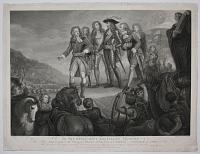
To the Kings most Excellent Majesty, This Plate the Landing of William Prince of Orange, in Torbay, on November the 5th 1688 is with His Gracious Permission humbly Dedicated, by his Majesty's most dutiful Subject & Servant, John Harris.
Painted by Ja.s Northcote Esq.r R.A. Engraved by Ja.s Parker.
Published Nov.r 5 1801 by John Harris No. 3 Sweetings Alley, Cornhill & 8 Old Broad Street London.
Line engraving, platemark 495 x 640mm (19½ x 25¼"). Small repaired tears; strong impression; collector's stamp verso.
Impressive scene after a work by history painter James Northcote depicting the arrival of William, Prince of Orange,in England in 1688, following which he replaced James II to be crowned William III in the 'Glorious Revolution' of that year. A banner in the upper right proclaims 'for the Protestant religion and liberty of England'. This print was published on November 5th 1801, the anniversary of the event it commemorates.
[Ref: 26209] £250.00
(£300.00 incl.VAT)
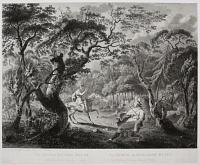
The Death of William Rufus. La Morte de Guillaume Rufus.
Design'd Painted & Engrav'd by Fras. Chesham.
Publish'd as the Act directs Oct. 15 1789 by F. Chesham No.8 Terrace Walworth Surry.
Engraving, very fine impression. 391 x 475mm (15½ x 18¾"). One fold and trimmed.
William Rufus falling to the ground after being hit by an arrow; deer seen running to the right. Other riders seen around the trees; the rider who shot him approaches utterly shocked. William Rufus, also known as William II (c.1056-1100) the third son of William I of England, and king of England from 1087 until his death. He was shot by an arrow by an nobleman named Walter Tirel, and was apparently then abandoned by the nobles at the place where he fell.
[Ref: 28982] £160.00
(£192.00 incl.VAT)
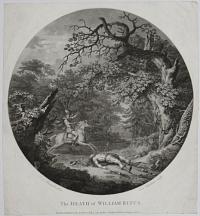
The Death of William Rufus.
J. Js. Barralet delin. Fras. Chesham sculp.
London, Published as the Act directs July 1 1783 by Fras. Chesham No.11 Great Poultney Street.
Etching and engravin, rare. 376 x 342mm (14¾ x 13½"). Surface rubbing, trimmed.
William Rufus lying on the ground in a clearing in the New Forest, an arrow through his chest, his plumed hat and quiver beside him, with another man riding past behind him, holding up his bow and looking down at the body; in an oval. William Rufus, also known as William II (c.1056-1100) the third son of William I of England, and king of England from 1087 until his death. He was shot by an arrow by an nobleman named Walter Tirel, and was apparently then abandoned by the nobles at the place where he fell.
[Ref: 28980] £190.00
(£228.00 incl.VAT)
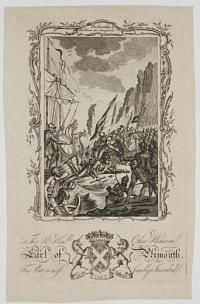
The Landing of William the Conqueror. To the Rt. Hon.ble Other Hickman, Earl of Plimouth. This Plate is most humbly Inscribed.
[n.d. c.1800.]
Engraving with small margins. Image and inscription plate separate; total plate area 249 x 158mm (9¾ x 6¼").
Soldiers disembarking from boats, where a knight has fallen on the ground.
[Ref: 34692] £65.00
(£78.00 incl.VAT)
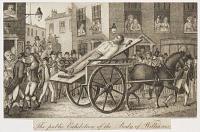
The public Exhibition of the Body of Williams.
[Anon, c.1811.]
Stipple, sheet 105 x 160mm (4 x 6¼"). Trimmed around image and title.
The body of John Williams, the principal suspect in the 'Ratcliff Highway Murders', a series of murders in East London in December 1811. Williams was arrested and imprisoned but before the case went to trial he used his scarf to hang himself in his cell at Coldbath Fields. The court declared Williams guilty of the crimes, taking his suicide as an admission of his guilt. Following this decision, Williams' corpse was paraded through the streets of East London, past the locations of the murders, in a procession supposedly seen by 180,000 people. Thomas De Quincey witnessed the event and wrote of it: 'When the cart came opposite the late Mr Marr's [one of the victims] house a halt was made for nearly a quarter of an hour. ... The procession then advanced to St George's Turnpike, where the New Road [now Commercial Road] is intersected by Cannon Street Road. Those who accompanied the procession arrived at a grave already dug six feet down. The remains of John Williams were tumbled out of the cart and lowered into this hole, and then someone hammered a stake through his heart.'
[Ref: 39205] £80.00
(£96.00 incl.VAT)




